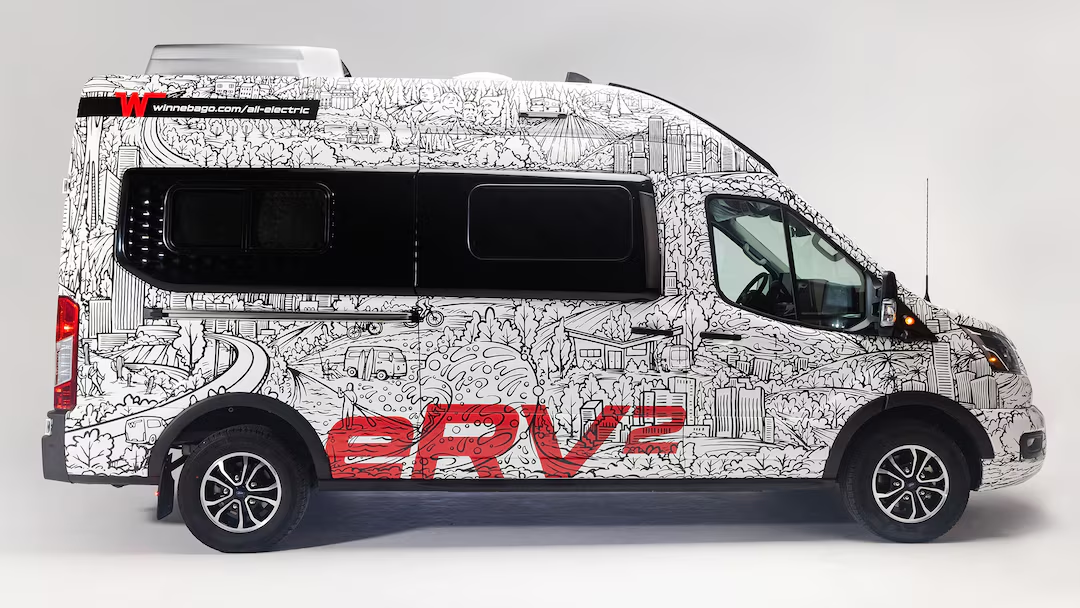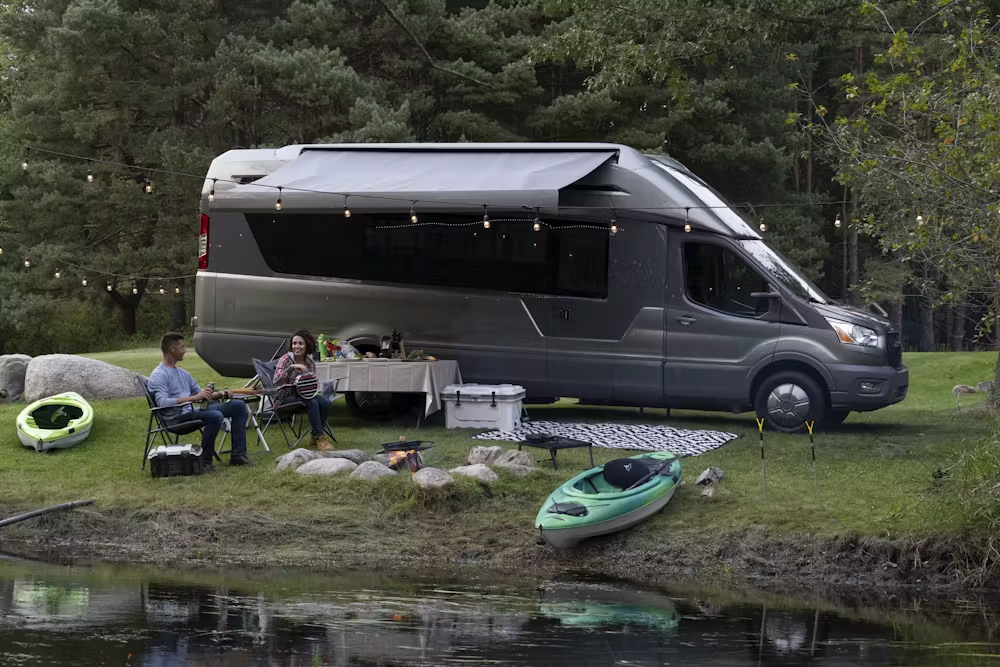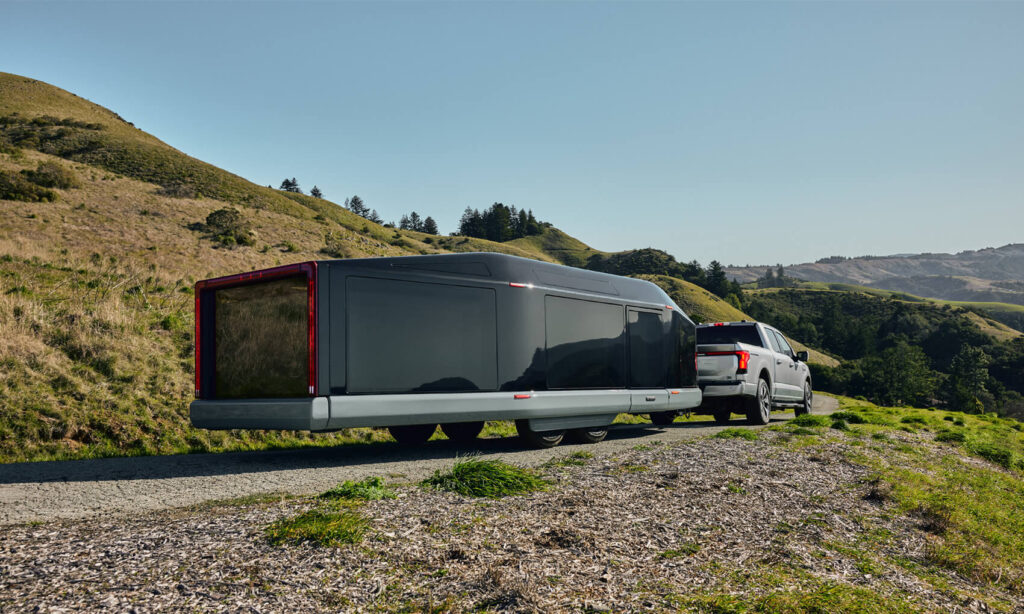Picture this: You’re nestled in a serene mountain campground, surrounded by the gentle rustling of leaves and the soothing sounds of nature. No roaring engines or diesel fumes to shatter the tranquility. Just you, the wilderness, and your whisper-quiet, zero-emission electric RV.
Sounds like a dream, right? Well, that dream is becoming a reality for more and more adventurers in 2024. The RV industry, once synonymous with gas-guzzling behemoths, is undergoing a quiet revolution. Electric RVs (eRVs) are rolling onto the scene, promising a cleaner, greener, and surprisingly luxurious way to explore the open road.
But are they just hype, or are electric RVs genuinely ready to take over the campground? In this guide, we’ll dive deep into the world of the best electric RVs, exploring their unique advantages, potential drawbacks, and spotlighting the most exciting models available today. Whether you’re a seasoned RVer itching to ditch the gas pump or a curious newbie dreaming of an eco-friendly adventure, this is your comprehensive roadmap to the future of RVing.
What Makes Electric RVs Different?
Forget everything you know about rumbling engines and smelly exhaust. Electric RVs are a whole new breed, powered by batteries instead of fossil fuels. Here’s how they work:
- The Heart of the Matter: eRVs store energy in large battery packs, which then power the vehicle’s motor, appliances, and onboard systems.
- Juice Up: Recharging is done by plugging into electric outlets, either at home (using Level 2 chargers) or at public charging stations (including faster DC fast chargers). Some models even come equipped with solar panels to harness the sun’s energy.
- Range Anxiety? This is the big question mark for many potential buyers. While electric car ranges have skyrocketed, eRVs still have catching up to do. Depending on the model and driving conditions, expect a range of roughly 100-200 miles per charge – for now.
So, are electric RVs the ultimate upgrade? Here’s the breakdown:
Pros:
- Zero Emissions: Say goodbye to guilt trips and hello to clean air. Electric RVs produce zero tailpipe emissions, helping you tread lightly on the environment.
- Silent Sanctuary: No more noisy generators! Enjoy peaceful campgrounds and wake up to birdsong, not engine rumble.
- Pocket-Friendly: While the upfront cost of an eRV might be higher, you’ll save big on fuel and maintenance in the long run.
- Tech-Savvy Features: Many eRVs come packed with smart technology, from energy monitoring systems to solar panels and app-controlled climate control.
Cons:
Upfront Cost: Electric RVs often have a higher initial price tag than their gas counterparts. However, this is balanced by lower operating costs over time.
Range Limitations: The biggest drawback for now is their relatively limited range. This might require more careful planning and shorter travel legs compared to gas RVs.
Charging Network: While the public charging network is growing, it’s not as extensive as gas stations, especially in remote areas.
Top Electric RVs on the Market in 2024: A Closer Look
The electric RV market is rapidly growing, with exciting new models emerging that cater to various lifestyles and budgets. Here are three standout electric RV models you’ll want to explore:

1. Winnebago e-RV2
- Price: Starting MSRP of around $130,000
- Range: Estimated 108 miles on a full charge
- Battery: 86 kWh
- Charging: Level 2 and DC fast charging capable
- Unique Features:
- Expansive solar panels for supplemental charging
- Smart energy management system
- Eco-friendly materials throughout the interior
- Pros: Established brand reputation, spacious interior, commitment to sustainability
- Cons: Limited range compared to some newer models, higher price point

2. Thor Vision Vehicle
- Price: Starting MSRP of around $330,000
- Range: Estimated 300 miles on a full charge
- Battery: 120 kWh (optional upgrade to 200 kWh for additional range)
- Charging: Level 2 and DC fast charging capable
- Unique Features:
- All-electric powertrain and chassis
- Modern, high-tech interior with smart features
- Option for a pop-top roof for added space
- Pros: Impressive range, luxury features, cutting-edge technology
- Cons: Significantly higher price point, limited availability initially

3. The Lightship L1
- Price: Estimated MSRP of $170,000
- Range: Up to 300 miles, due to aerodynamic design and efficient energy management
- Battery: 80 kWh
- Charging: Level 2 and DC fast charging capable
- Unique Features:
- Integrated solar panels
- All-electric appliances (HVAC, water heater, etc.)
- Modern, minimalist interior design
- Pros: Promising range, sleek design, emphasis on efficiency and sustainability
- Cons: Newer company, limited track record, potentially long wait times for delivery
Electric Camper Vans: A Smaller, Nimbler Option
If the larger RVs feel like too much, don’t worry! Electric camper vans are also making waves. Models like the Volkswagen ID. Buzz and Mercedes-Benz EQV offer the freedom of van life with the added benefits of electric power. While they have less living space than traditional RVs, they often boast better maneuverability and lower prices.
Important Note: The electric RV market is still evolving rapidly, and prices and specifications are subject to change. Always verify the latest information with manufacturers and reputable dealers before making a purchase decision.
With this detailed look at the top electric RVs in 2024, you’re well on your way to finding the perfect model for your next eco-friendly adventure. Let me know when you’re ready for the next section on choosing the right electric RV!
IV. Tips for Choosing the Right Electric RV: Your Ultimate Guide
The allure of silent campgrounds and zero-emission adventures is tempting, but choosing the best electric RV (eRV) requires careful consideration. This comprehensive guide will equip you with the knowledge to make a decision that aligns with your lifestyle, budget, and wanderlust.
Define Your Needs and Wants:
- Size and Sleeping Capacity: How many people will be traveling? Are you a solo adventurer, a couple, or a family? Consider the number of beds, living space, and storage you’ll need.
- Travel Style: Do you envision long cross-country journeys, weekend getaways to national parks, or boondocking off the grid? Different eRVs excel in different scenarios, so tailor your choice to your typical adventures.
- Budget: Electric RVs typically have a higher upfront cost than traditional gas models. Set a realistic budget and explore financing options that align with your financial situation.
Range Anxiety: A Reality Check
- Understand Range Limitations: Be honest with yourself about the current limitations of eRV range. Most models offer between 100-300 miles on a single charge. Plan your trips around available charging stations and factor in potential range reductions due to terrain, weather, and driving habits.
- Utilize Range-Extending Options: Look for eRVs with solar panels or generator options to supplement battery power. This can be a game-changer for longer trips or boondocking adventures.
The Charging Conundrum
- Research Charging Infrastructure: Before committing to an eRV, map out your typical routes and ensure there are enough charging stations along the way. Use resources like PlugShare to locate charging stations and plan your journeys accordingly.
- Charging Speed Matters: Consider how long you’re willing to wait at charging stations. Level 2 charging can take several hours, while DC fast charging can replenish your battery significantly faster.
Financial Considerations
- Upfront Investment: Brace yourself for a potentially higher price tag than a comparable gas RV. However, remember that you’ll save on fuel costs in the long run.
- Incentives and Rebates: Many states and utilities offer incentives for electric vehicles, including RVs. Research available programs to see if you qualify for any financial assistance.
- Resale Value: While the resale market for eRVs is still developing, early adopters might benefit from increased demand and potential tax incentives in the future.
Test Drive and Research
- Get Behind the Wheel: If possible, test drive different electric RV models to get a feel for their handling, features, and overall comfort.
- Read Reviews: Explore reviews from other eRV owners to gain insights into their experiences, both positive and negative.
- Compare Features: Scrutinize the specifications of different models to find the one that best suits your needs and preferences.
Making the Switch: A Wise Investment
Choosing the best electric RV might take some extra research and planning, but the rewards are substantial. You’ll enjoy quieter, cleaner adventures, lower operating costs, and the satisfaction of contributing to a greener future.
With the right knowledge and preparation, your electric RV journey can be as smooth and exhilarating as the open road itself.
V. The Future of Electric RVs: Charging Toward New Horizons
Electric RVs (eRVs) are making waves now, but the future is even more electrifying (pun intended!). Here’s a glimpse into what’s on the horizon for these eco-friendly adventurers:
Industry Momentum: It’s Electric!
Consumer demand for eRVs is surging, driven by environmental concerns, rising gas prices, and a desire for quieter, more tech-savvy camping experiences. This growing interest is fueling innovation and investment in the electric RV space, promising rapid advancements in the coming years.
Battery Breakthroughs: Range on the Rise
One of the most exciting areas of development is battery technology. Expect to see eRVs with even larger battery packs, offering extended ranges and reducing the need for frequent charging. This means more freedom to roam and longer journeys between plug-ins.
Charging Networks: Expanding Your Horizons
The charging infrastructure for electric vehicles is growing exponentially, and that includes RVs. Expect to see more charging stations popping up at campgrounds, RV parks, and even popular roadside destinations. This expansion will make long-distance travel in an eRV more accessible and convenient.
Tech-Savvy RVs: A Glimpse into the Future
Electric RVs are already known for their advanced features, but the future holds even more innovation. Imagine RVs with:
- Vehicle-to-Grid (V2G) Technology: This allows your eRV to not only store energy but also send it back to the grid when needed, potentially offsetting your energy costs or even earning you some extra cash.
- Smart Home Integration: Control your RV’s lights, temperature, and other functions remotely using your smartphone or voice commands.
- Autonomous Driving Features: While still in development, self-driving technology could eventually make RVing even more relaxing and accessible.
The Road Ahead: Challenges and Opportunities
The electric RV revolution is still in its early stages, and some challenges remain. The higher upfront costs of eRVs can be a barrier for some buyers, and the charging infrastructure still needs to catch up in some areas.
However, the opportunities for growth are immense. As battery technology continues to improve, charging networks expand, and more manufacturers enter the market, electric RVs could become the norm rather than the exception.
VII. Conclusion: Your Electric Adventure Awaits
The future of RVing is electric, and it’s brighter than ever. Whether you’re drawn to the environmental benefits, the quiet operation, or the cutting-edge technology, electric RVs offer a compelling alternative to traditional gas-powered models.
With more models hitting the market and charging infrastructure expanding, there’s never been a better time to consider making the switch to an electric RV. So, why not ditch the gas pump and embrace a quieter, cleaner, and more sustainable way to explore the great outdoors? Your next adventure awaits, and it might just be powered by electricity.


